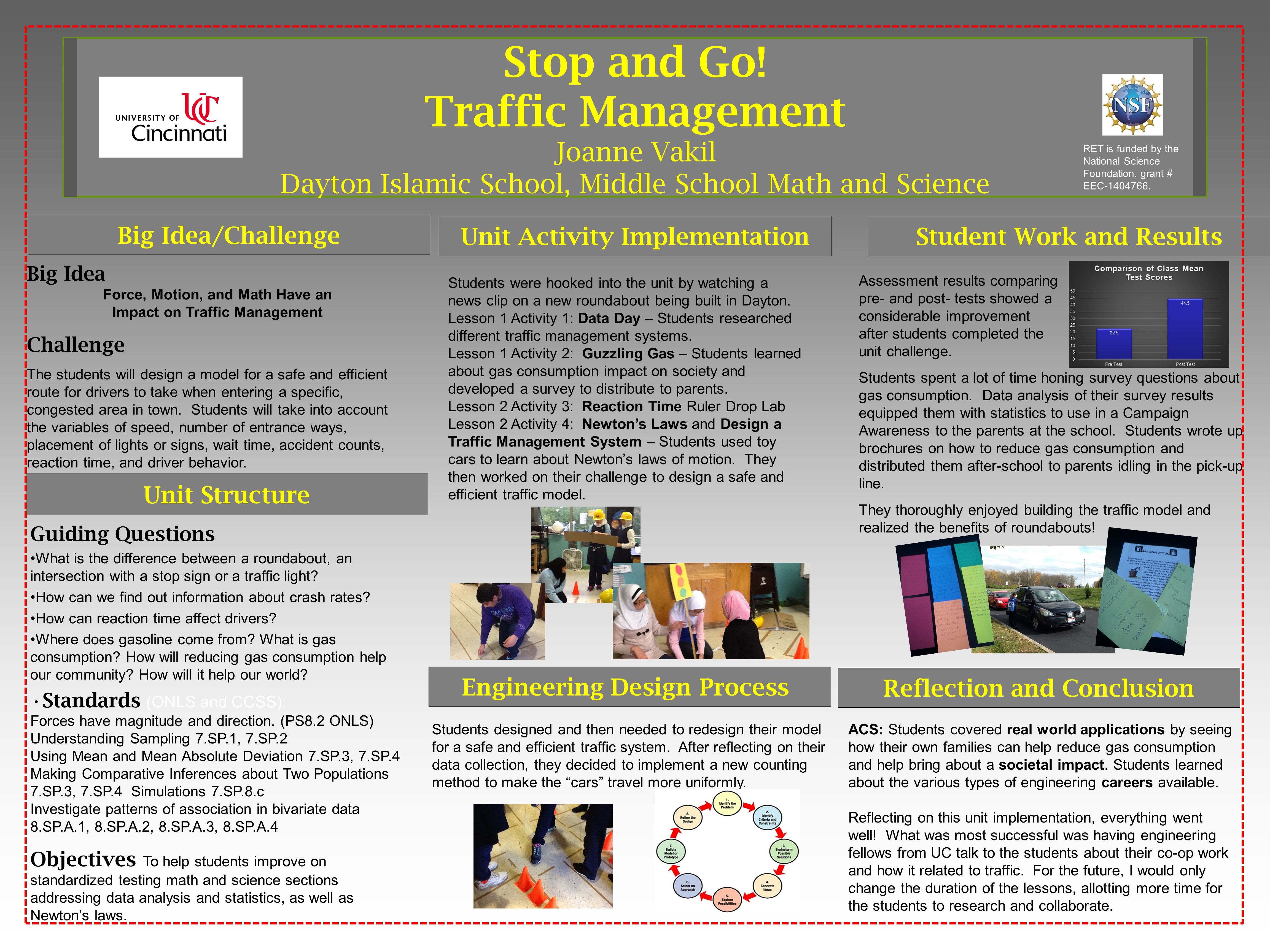Research Experience for Teachers (2014-2015)
Stop and Go: Designing an Efficient Route to Help Reduce Gas Consumption
 |
||||||
|
||||||
|
Pre/Post Test: |
||||||
|
The Big Idea (including global relevance) Force, Motion, and Math’s Impact on Traffic Management With the United States using approximately half of the world’s gasoline, it is imperative that we address how we can start changing our habits of gas consumption. According to the U.S. Energy Information Administration, about 134.51 billion gallons of gasoline were consumed in the United States. Idling in traffic alone utilizes over 8 million gallons of gasoline per day, which is equivalent to a 25 acre lake of gas. In this unit, students will review Common Core math statistics standards and learn concepts of forces and motion, specifically, that forces between objects act when the objects are in direct contact or when they are not touching, while exploring the impact of traffic management on their local and global community. Using Challenge-based learning, students will work in groups and come up with a list of essential questions that will explore issues of gas consumption and traffic. Back as a whole class, students will see which essential questions overlap and lead towards the following essential question.
|
|
Essential Questions
|
|
The Hook Have any of you driven on Ohio 235 and 41 over the summer? Clark County is currently constructing a first-of-its kind roundabout. The project will cost $1.1 million. What dangerous intersection problems and driving habits led to the approval of this particular type of traffic management plan? How does it compare to the 17 traffic circles located in Dublin, Ohio? Does our city of Beavercreek need a roundabout? What impact would roundabouts have on our traffic and what positive or negative effects would it have on our nation’s gas consumption? These are the questions students will be discussing on the first day. Visuals such as photos and new articles will be presented to the class. Students will have a chance to walk around four posters laid out on tables and briefly write about some of their pre-knowledge on traffic and gas consumption, as well as their own experiences with time, speed, and traffic. A guest speaker, either a civil engineer or a police officer, will be scheduled to talk to the class about traffic issues. As a back-up, students will view online clips of police officers directing traffic manually on busy intersections and a clip of how a roundabout operates. |
|
The Challenge The students will design a model for a safe and efficient route for drivers to take when entering a specific, congested area in town. Students will take into account the variables of speed, number of entrance ways, placement of lights or signs, wait time, accident counts, reaction time, and driver behavior. The constraints will include the following: a designated intersection (agreed upon by the teacher and students), a maximum testing of 30 vehicles, a range of speed (to be determined once human pace and battery operated vehicle speed are calculated), a maximum of six entrance ways into the congested area, and the amount of allowable gas emission (if applicable, to be determined). |
|
Guiding Questions
|
ACS (Real world applications; career connections; societal impact)
Students will deliver an awareness campaign on the current global gas consumption problems and convey the steps families can take to help contribute to reducing gas consumption.
Students will learn about the environmental impact of gas consumption. Upon research students will realize the geographical and political aspects of gasoline production and consumption, as well as its scientific effects on the planet.
Career connections to civil, environmental, petroleum, transportation and mechanical design engineering; Students may also consider a future as an inventor or industrial or governmental mathematician.
Misconceptions
- Students are not aware of the precision and accuracy involved with traffic signaling and traffic management.
- Students use the terms speed and velocity as synonyms.
- Only animate objects can exert a force.
- Force is a property of an object.
- An object has force and when it runs out of force, it stops moving.
- Large objects exert a greater force than small objects.
- Mass and weight are synonyms.
Unit Lessons and Activities
- Lesson 1:
- Activity 1: Data Day
- Activity 2: Guzzling Gas
- Lesson 2:
- Activity 3: Don’t Overreact: Reaction Time and Other Driver Behavior Issues on the Road:
- Activity 4: Stop and Go! Design a Traffic Management System and Model
- Evidence of CBL: Lesson 2 Activity 4
- Evidence of EDP: Lesson 2 Activity 4
Additional Resources
- Article: "Why is U.S. Oil Consumption Lower? Better Gasoline Mileage?"
http://ourfiniteworld.com/2013/01/31/why-is-us-oil-consumption-lower-better-gasoline-mileage/ - Article: "Anti-Idling Primer"
http://www.thehcf.org/antiidlingprimer.html - Article: "Car Pollution Facts"
http://www.evsroll.com/Car_pollution_facts.html - Article: "Construction starts on first-of-its kind roundabout" Tiffany Latta, Dayton Daily News, June 30, 2014
http://www.daytondailynews.com/news/news/transportation/construction-starts-on-first-of-its-kind-roundabou/ngTjR/ - http://www.epa.gov/otaq/ld-hwy.htm
- http://ci.beavercreek.oh.us/public-works-infrastructure-improvements/
- http://www.eia.gov/tools/faqs/faq.cfm?id=23&t=10
- http://safety.fhwa.dot.gov/intersection/roundabouts/
- http://www.learners-guide.co.uk/lessons/roundabouts/
